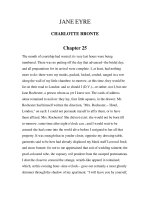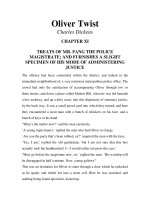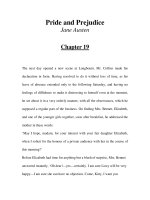LUYỆN ĐỌC TIẾNG ANH QUA TÁC PHẨM VĂN HỌC-JOURNEY TO THE CENTER OF THE EARTH -JULES VERNE- CHAPTER 6 pot
Bạn đang xem bản rút gọn của tài liệu. Xem và tải ngay bản đầy đủ của tài liệu tại đây (27.32 KB, 12 trang )
JOURNEY TO THE CENTER OF THE EARTH
JULES VERNE
CHAPTER 6
EXCITING DISCUSSIONS ABOUT AN UNPARALLELED
ENTERPRISE
At these words a cold shiver ran through me. Yet I controlled myself;I even
resolved to put a good face upon it. Scientific argumentsalone could have
any weight with Professor Liedenbrock. Now therewere good ones against
the practicability of such a journey.Penetrate to the centre of the earth! What
nonsense! But I kept mydialectic battery in reserve for a suitable
opportunity, and Iinterested myself in the prospect of my dinner, which was
not yetforthcoming.
It is no use to tell of the rage and imprecations of my uncle beforethe empty
table. Explanations were given, Martha was set at liberty,ran off to the
market, and did her part so well that in an hourafterwards my hunger was
appeased, and I was able to return to thecontemplation of the gravity of the
situation.
During all dinner time my uncle was almost merry; he indulged in someof
those learned jokes which never do anybody any harm. Dessert over,he
beckoned me into his study.
I obeyed; he sat at one end of his table, I at the other.
"Axel," said he very mildly; "you are a very ingenious young man, youhave
done me a splendid service, at a moment when, wearied out withthe struggle,
I was going to abandon the contest. Where should I havelost myself? None
can tell. Never, my lad, shall I forget it; and youshall have your share in the
glory to which your discovery will lead."
"Oh, come!" thought I, "he is in a good way. Now is the time fordiscussing
that same glory."
"Before all things," my uncle resumed, "I enjoin you to preserve themost
inviolable secrecy: you understand? There are not a few in thescientific
world who envy my success, and many would be ready toundertake this
enterprise, to whom our return should be the firstnews of it."
"Do you really think there are many people bold enough?" said I.
"Certainly; who would hesitate to acquire such renown? If thatdocument
were divulged, a whole army of geologists would be ready torush into the
footsteps of Arne Saknussemm."
"I don't feel so very sure of that, uncle," I replied; "for we haveno proof of
the authenticity of this document."
"What! not of the book, inside which we have discovered it?"
"Granted. I admit that Saknussemm may have written these lines. Butdoes it
follow that he has really accomplished such a journey? Andmay it not be
that this old parchment is intended to mislead?"
I almost regretted having uttered this last word, which dropped fromme in an
unguarded moment. The Professor bent his shaggy brows, and Ifeared I had
seriously compromised my own safety. Happily no greatharm came of it. A
smile flitted across the lip of my severecompanion, and he answered:
"That is what we shall see."
"Ah!" said I, rather put out. "But do let me exhaust all the possibleobjections
against this document."
"Speak, my boy, don't be afraid. You are quite at liberty to expressyour
opinions. You are no longer my nephew only, but my colleague.Pray go on."
"Well, in the first place, I wish to ask what are this Jokul, thisSneffels, and
this Scartaris, names which I have never heard before?"
"Nothing easier. I received not long ago a map from my friend,Augustus
Petermann, at Liepzig. Nothing could be more apropos. Takedown the third
atlas in the second shelf in the large bookcase,series Z, plate 4."
I rose, and with the help of such precise instructions could not failto find the
required atlas. My uncle opened it and said:
"Here is one of the best maps of Iceland, that of Handersen, and Ibelieve this
will solve the worst of our difficulties."
I bent over the map.
"You see this volcanic island," said the Professor; "observe that allthe
volcanoes are called jokuls, a word which means glacier inIcelandic, and
under the high latitude of Iceland nearly all theactive volcanoes discharge
through beds of ice. Hence this term ofjokul is applied to all the eruptive
mountains in Iceland."
"Very good," said I; "but what of Sneffels?"
I was hoping that this question would be unanswerable; but I wasmistaken.
My uncle replied:
"Follow my finger along the west coast of Iceland. Do you seeRejkiavik, the
capital? You do. Well; ascend the innumerable fiordsthat indent those sea-
beaten shores, and stop at the sixty-fifthdegree of latitude. What do you see
there?"
"I see a peninsula looking like a thigh bone with the knee bone atthe end of
it."
"A very fair comparison, my lad. Now do you see anything upon thatknee
bone?"
"Yes; a mountain rising out of the sea."
"Right. That is Snæfell."
"That Snæfell?"
"It is. It is a mountain five thousand feet high, one of the mostremarkable in
the world, if its crater leads down to the centre ofthe earth."
"But that is impossible," I said shrugging my shoulders, anddisgusted at such
a ridiculous supposition.
"Impossible?" said the Professor severely; "and why, pray?"
"Because this crater is evidently filled with lava and burning rocks,and
therefore -"
"But suppose it is an extinct volcano?"
"Extinct?"
"Yes; the number of active volcanoes on the surface of the globe isat the
present time only about three hundred. But there is a verymuch larger
number of extinct ones. Now, Snæfell is one of these.Since historic times
there has been but one eruption of thismountain, that of 1219; from that time
it has quieted down more and.more, and now it is no longer reckoned among
active volcanoes."
To such positive statements I could make no reply. I therefore tookrefuge in
other dark passages of the document.
"What is the meaning of this word Scartaris, and what have thekalends of
July to do with it?"
My uncle took a few minutes to consider. For one short moment I felta ray
of hope, speedily to be extinguished. For he soon answered thus:
"What is darkness to you is light to me. This proves the ingeniouscare with
which Saknussemm guarded and defined his discovery.Sneffels, or Snæfell,
has several craters. It was therefore necessaryto point out which of these
leads to the centre of the globe. Whatdid the Icelandic sage do? He observed
that at the approach of thekalends of July, that is to say in the last days of
June, one of thepeaks, called Scartaris, flung its shadow down the mouth of
thatparticular crater, and he committed that fact to his document. Couldthere
possibly have been a more exact guide? As soon as we havearrived at the
summit of Snæfell we shall have no hesitation as tothe proper road to take."
Decidedly, my uncle had answered every one of my objections. I sawthat his
position on the old parchment was impregnable. I thereforeceased to press
him upon that part of the subject, and as above allthings he must be
convinced, I passed on to scientific objections,which in my opinion were far
more serious.
"Well, then," I said, "I am forced to admit that Saknussemm'ssentence is
clear, and leaves no room for doubt. I will even allowthat the document
bears every mark and evidence of authenticity. Thatlearned philosopher did
get to the bottom of Sneffels, he has seenthe shadow of Scartaris touch the
edge of the crater before thekalends of July; he may even have heard the
legendary stories told inhis day about that crater reaching to the centre of the
world; but asfor reaching it himself, as for performing the journey,
andreturning, if he ever went, I say no - he never, never did that."
"Now for your reason?" said my uncle ironically.
"All the theories of science demonstrate such a feat to beimpracticable."
"The theories say that, do they?" replied the Professor in the toneof a meek
disciple. "Oh! unpleasant theories! How the theories willhinder. us, won't
they?"
I saw that he was only laughing at me; but I went on all the same.
"Yes; it is perfectly well known that the internal temperature risesone degree
for every 70 feet in depth; now, admitting this proportionto be constant, and
the radius of the earth being fifteen hundredleagues, there must be a
temperature of 360,032 degrees at the centreof the earth. Therefore, all the
substances that compose the body ofthis earth must exist there in a state of
incandescent gas; for themetals that most resist the action of heat, gold, and
platinum, andthe hardest rocks, can never be either solid or liquid under such
atemperature. I have therefore good reason for asking if it ispossible to
penetrate through such a medium."
"So, Axel, it is the heat that troubles you?"
"Of course it is. Were we to reach a depth of thirty miles we shouldhave
arrived at the limit of the terrestrial crust, for there thetemperature will be
more than 2372 degrees."
"Are you afraid of being put into a state of fusion?"
"I will leave you to decide that question," I answered rathersullenly. "This is
my decision," replied Professor Liedenbrock,putting on one of his grandest
airs. "Neither you nor anybody elseknows with any certainty what is going
on in the interior of thisglobe, since not the twelve thousandth part of its
radius is known;science is eminently perfectible; and every new theory is
soon routedby a newer. Was it not always believed until Fourier that
thetemperature of the interplanetary spaces decreased perpetually? andis it
not known at the present time that the greatest cold of theethereal regions is
never lower than 40 degrees below zero Fahr.? Whyshould it not be the
same with the internal heat? Why should it not,at a certain depth, attain an
impassable limit, instead of rising tosuch a point as to fuse the most infusible
metals?"
As my uncle was now taking his stand upon hypotheses, of course,there was
nothing to be said.
"Well, I will tell you that true savants, amongst them Poisson,
havedemonstrated that if a heat of 360,000 degrees [1] existed in theinterior
of the globe, the fiery gases arising from the fused matterwould acquire an
elastic force which the crust of the earth would beunable to resist, and that it
would explode like the plates of abursting boiler."
"That is Poisson's opinion, my uncle, nothing more."
"Granted. But it is likewise the creed adopted by other
distinguishedgeologists, that the interior of the globe is neither gas nor
water,nor any of the heaviest minerals known, for in none of these
caseswould the earth weigh what it does."
"Oh, with figures you may prove anything!"
"But is it the same with facts! Is it not known that the number ofvolcanoes
has diminished since the first days of creation? and ifthere is central heat
may we not thence conclude that it is inprocess of diminution?"
"My good uncle, if you will enter into the legion of speculation, Ican discuss
the matter no longer."
"But I have to tell you that the highest names have come to thesupport of my
views. Do you remember a visit paid to me by thecelebrated chemist,
Humphry Davy, in 1825?"
"Not at all, for I was not born until nineteen years afterwards."
"Well, Humphry Davy did call upon me on his way through Hamburg.
Wewere long engaged in discussing, amongst other problems, thehypothesis
of the liquid structure of the terrestrial nucleus. Wewere agreed that it could
not be in a liquid state, for a reasonwhich science has never been able to
confute."
[1] The degrees of temperature are given by Jules Verne according tothe
centigrade system, for which we will in each case substitute theFahrenheit
measurement. (Tr.)
"What is that reason?" I said, rather astonished.
"Because this liquid mass would be subject, like the ocean, to thelunar
attraction, and therefore twice every day there would beinternal tides, which,
upheaving the terrestrial crust, would causeperiodical earthquakes!"
"Yet it is evident that the surface of the globe has been subject tothe action
of fire," I replied, "and it is quite reasonable tosuppose that the external crust
cooled down first, whilst the heattook refuge down to the centre."
"Quite a mistake," my uncle answered. "The earth has been heated
bycombustion on its surface, that is all. Its surface was composed of agreat
number of metals, such as potassium and sodium, which have thepeculiar
property of igniting at the mere contact with air and water;these metals
kindled when the atmospheric vapours fell in rain uponthe soil; and by and
by, when the waters penetrated into the fissuresof the crust of the earth, they
broke out into fresh combustion withexplosions and eruptions. Such was the
cause of the numerousvolcanoes at the origin of the earth."
"Upon my word, this is a very clever hypothesis," I exclaimed, inspite rather
of myself.
"And which Humphry Davy demonstrated to me by a simple experiment.
Heformed a small ball of the metals which I have named, and which was
avery fair representation of our globe; whenever he caused a fine dewof rain
to fall upon its surface, it heaved up into littlemonticules, it became
oxydized and formed miniature mountains; acrater broke open at one of its
summits; the eruption took place, andcommunicated to the whole of the ball
such a heat that it could notbe held in the hand."
In truth, I was beginning to be shaken by the Professor's arguments,besides
which he gave additional weight to them by his usual ardourand fervent
enthusiasm.
"You see, Axel," he added, "the condition of the terrestrial nucleushas given
rise to various hypotheses among geologists; there is noproof at all for this
internal heat; my opinion is that there is nosuch thing, it cannot be; besides
we shall see for ourselves, and,like Arne Saknussemm, we shall know
exactly what to hold as truthconcerning this grand question."
"Very well, we shall see," I replied, feeling myself carried off byhis
contagious enthusiasm. "Yes, we shall see; that is, if it ispossible to see
anything there."
"And why not? May we not depend upon electric phenomena to give
uslight? May we not even expect light from the atmosphere, the pressureof
which may render it luminous as we approach the centre?"
"Yes, yes," said I; "that is possible, too."
"It is certain," exclaimed my uncle in a tone of triumph. "Butsilence, do you
hear me? silence upon the whole subject; and let noone get before us in this
design of discovering the centre of theearth."









